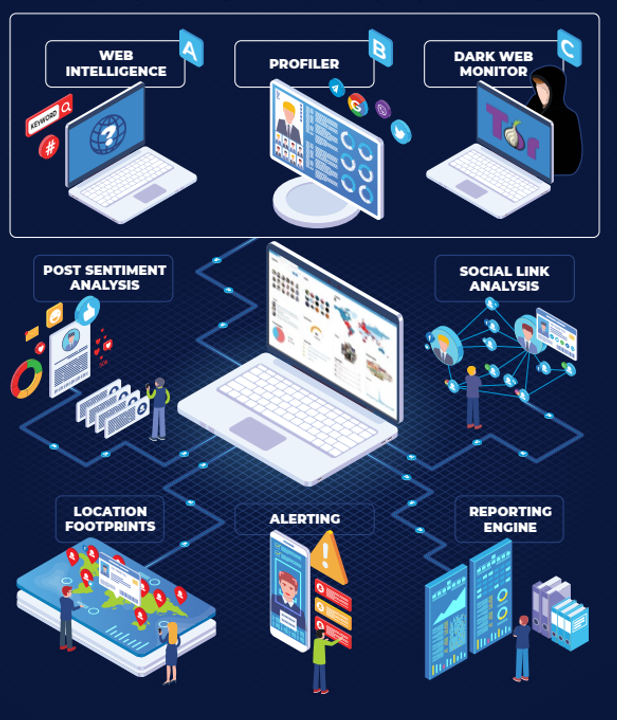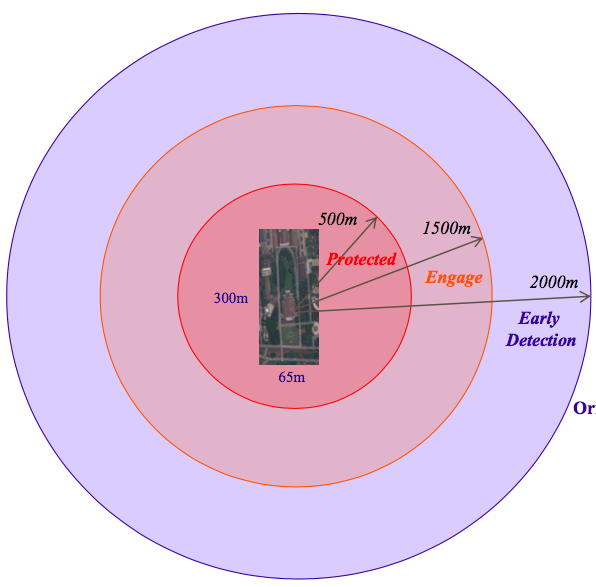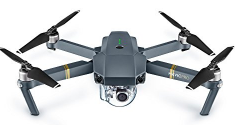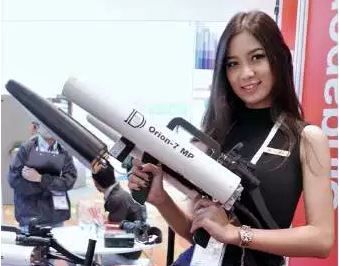NEWS
Business continuity and operational resilience
Information is king, but which information? In a world where information is abundance yet full of contradictory and misleading information, enterprise intelligence provides situational awareness of cyber threats, security risks, political instability, or other trouble brewing. The need for filtering information to make business decisions is crucial.
Smart data analysis to create information which provide useful intelligence is the key of successful decision making. Intelligence is the first step in understanding your risk
Business leaders consciously use intelligence to shape their decisions. Intelligence functions help leaders understand what is really happening and what is likely to happen next. Intelligence demonstrated ability to provide strategic guidance and support to senior executives on opportunities and trends, as well as risks, across the gamut of corporate activities.
Companies invest in security and intelligence because it helps the bottom line. If your company does not have an intelligence function, your competitors likely do. And even if you do, you may not be using it to optimum effect.
These where our role can help you achieve the level of intelligence you need most, clearly and real. We at PT Multisystem Infra Engineering, helps you collect data, manage dan process data, then Analyze them to create useful intelligence thus helps planning and decisions making easier and on point.
CYBER RISK MITIGATION IS OUR BUSINESS


Daily effort to get better, smarter and always reach high goal is one of our value in PT MULTISYSTEM INFRA ENGINEERING, wherther through formal education, sharpening skills by training, or having good intelectual conversation at the coffee shop.
This year is the third year that we support nusanta.run whose goal is to better Indonesian education by supporting and raising fund for child education and their teachers all over Indonesia.
This year we support nusanta.run for its 5th event. During the 127.9 km from Purwokerto to Dieng runners will experience different multitude of views, terrain and local hospitality. Nusantarun contribution will be focused on creating a sustainable impact in Dieng that is centered around education. Nusantarun are collaborating with IOA and local schools to execute this program. With its target of 2 Billion rupiah fundraised we hope this can create enough impact to change condition in Dieng.

Technology Overview
Commercially available Anti-Drone solutions usually use jammer (jamming the frequencies used by the drones to make the drone crash or go away), net (by another drone or from the ground shooter), and eagle (to catch and stop the drones) and so on. However, our solution is different from these. We design our Anti-Drone solution with the main intention of taking over the control of the drone. Instead of blindly jamming the frequency signal, our system scans (all Wi-Fi 802.11a/b/g/n 2.4GHz and 5.0GHz frequency bands), detect and identify the particular drone and disable the drone fight controller if the drone intrudes a restricted flying zone. That means our solution will not affect other nearby equipment which might use similar frequencies as the drone. Also, our solution can automatically monitor the designated area all the time in order to detect drone intrusion. That allows our solution to work 24 hours a day without the need of human intervention.
Technology Features & Specifications
- Scan - Able to scan surrounding area for all IEEE 802.11a/b/g/n 2.4GHz and 5.0GHz frequencies band. List out all AP SSID including Drone SSIDs and MAC Addresses. Can filter and list only Drone SSIDs.
- Detect - Able to detect Drone flying in the scan vicinity coverage area. List out all the Drones by SSIDs and MAC Addresses.
- Take Control - Able to take over control of Drone by disconnecting original user that is controlling the Drone.
- Mitigate - Able to instruct the intruding Drone to land gracefully or fly back to its original location
- Black & White List - Able to automatically scan, detect and take over control of Drone that is not listed in the White List.
- Slave and Master Antenna Nodes - Able to setup Antenna Slave and Master Nodes for big scale deployment where Slave Nodes can send back the real-time data back to the Master Node with central management capability.
- Alert and Status - Able to provide alert if any Drone is detected within the coverage area. Provides status of all Antenna Nodes and the action taken (success or failure).
Potential Applications
The Anti-Drone solutions is suitable for both private and public sectors.
- Public sectors - Protection of Government Buildings, President Palace, Parliament House, Military Base (Land, Air, Maritime) and Police Bases etc.
- Private sectors - Protection of Airport, Power Plant and Transmission Station, Telecommunication Radar and Satellite, Stadium (For example: France deploys Anti-Drone solutions to protect Euro 2016), Train Station, Shopping Mall, High Rises Office and Hotel Buildings etc.
There are too many incidents on Drones in near miss with Aircraft that resulted in FAA (USA) and many Airport Authorities looking for a strategic solution.
Customer Benefits
Our Anti-Drone solution is capable of detecting and identifying commercial and hobbies drones; mitigate and take control of Drones by means of innovative interceptions; and neutralize potential terrorist attacks through the use of Drones. It also helps to preserve and extract any evidence captured for further analysis and investigations by the authority.
Source: https://www.ipi-singapore.org/technology-offers/anti-drone-solution

Drones have literally taken off in the last few years. But when it comes to buying one, there's a lot to consider. First off, you'll have to decide what your primary needs are for it. Are you just starting out and looking for a beginners' model? Do you just want a cheap model to play around with? Or do you want to use it to take aerial pictures and video? To help you decide which drone might be best for you, read our top eight picks below (and before you use it, be sure to read about the rules and regulations on the FAA website).
DJI’s Mavic Pro can be summed up in three words: portable and powerful. Capable of collapsing down to as small as a bottle of water, DJI Mavic Pro is a fantastic choice for quadcopter fans. A new OcuSync transmission system will offer up to 4.3 miles of range, 40 mph speed and a flight time around 27 minutes, thanks to a powerful battery. The lengthy range away from the base controller is aided by GPS and satellite to help maintain precise location control. Thanks to sensor redundancy, the inclusion of obstacle avoidance will help the Mavic Pro dodge anything that could knock it out of the sky.
Visually, the 3.27 x 7.8 x 3.27-inch Mavic Pro looks and feels different from DJI’s wildly popular existing quadcopter line and has more contour and angular shapes. It almost gives off the appeal of a stealth bomber, rather than the stark white Phantom line. Shorter legs give the Mavic Pro the appearance of landing on its belly, and the rear arms pivot downward to tuck in the underside while the front arms fold inward toward the top of the main body. Recreating the camera and three-axis gimbal system allows DJI’s designers to create such a backpack-friendly design.
Setup is a snap and, after connecting to the remote control, you can add a smartphone to act as a screen. The compact remote is as well designed as the Mavic Pro itself, with two joysticks controlling height, direction and motion. One scroll wheel on the back adjusts the camera gimbal and the other is open to programming. The camera records 4K video at 30fps or 1080p at 96fps, the latter of which can live stream to Facebook, YouTube, and Periscope at 30fps. Additionally, you can capture stills with the 12-megapixel camera.
Runner-Up, Best Overall: Best Camera: DJI Phantom 4
The Phantom 4 continues DJI’s dominance in the drone market and it's the best camera drone out there. And it comes complete with additional features and functionalities to justify its high price tag. At just over three pounds, most of the Phantom 4’s additional weight over the Phantom 3 Professional comes from the 5,350mAh battery. Both novice fliers and experts will find the Phantom 4 easy to navigate partially due to a safety system that detects obstacles ahead and stops the Phantom 4 in its tracks. It’s not foolproof, but it’s one of the many fine points that helps make this drone well worth the price of admission.
Capable of speeds of up to 45 mph, the Phantom 4 can fly four miles above sea level, but FAA regulations will cut that down to about 400 feet in an area with tight restrictions. Multiple flight modes including autonomous flying, sport mode, positioning and more allow for various capabilities, all of which are handled beautifully by the incredible controller. The 28-minute flight time and 75-minute recharge time puts the Phantom 4 among the best at this price range.
With a fixed f/2.8 aperture and 4K video capture, it’s the camera that truly stands out on this drone. Images can be captured in either JPG, RAW DNG or RAW + JPG at 12-megapixel resolution. The 4K video recording maxes out at 30fps and dropping video quality down to 1080p will add 48, 50, 60 and 120fps shooting. The gimbal does an excellent job of leveling out the camera as you’re flying around and helps avoid some of the shaking and twisting of the drone body from appearing or affecting video. If you’re grabbing 4K video, you’ll want to consider that you can fill up a 16GB memory card during the course of a single flight. Slight caveats aside, the Phantom 4 is one of the best drones available.
While we often look to higher price ranges for the very best in quadcopter and drone technology, there’s plenty of budget options we shouldn’t ignore. The wallet-friendly Syma X5SC offers HD video and pictures, headless mode, a sturdy frame, six to eight minutes of flight time and a 150-foot range of flight. Unfortunately, recharging the 500mAh battery takes two hours, but you have to understand that there will be trade-offs at this price point.
However, for a drone that’s just under .24 pounds, we’re not surprised that stability outdoors is a challenge. A slight burst of wind and it can take some time with the controls to bring the unit back to stability. One last disappointment is the camera, a 2mp camera leads to average photos and, while our expectations are tempered for the price, we’d love to see slightly higher quality photos. Fortunately, the X5SC is very durable and online reviews mention people crashing into doors, trees, walls, ceilings and more with nary a scratch on the unit. The good news is that, for the price, replacement parts are cheap should you ever find yourself in need of new blades or blade protectors.
Although flight time can be short, additional batteries can be purchased for under $20. Even with some shortfalls at the entry-level price, the Syma X5SC is an outstanding value and a ton of fun, earning an easy recommendation as your budget option.
If you've never flown a drone before, it’s best to start small, start inexpensive and start with something great. The Syma X5C hits all three of these requirements. Praised by general technology and drone-specific sites alike, the Syma is a great way to introduce yourself to the drone world. There’s nothing here that will knock your socks off and the SYMA is just a great introductory drone.
At just 2.1 pounds, the X5C is capable of a seven-minute flight time supported by a 100-minute recharge time. That’s all fairly standard in the price range of the X5C. However, unlike some its similarly-priced competition, the X5C is capable of being flown both indoors and outdoors, thanks to a wind-resistant build. A six-axis gyro stabilization helps ensure that the X5C has maximum stability during its flight time. Equipped with a 720p HD camera and 2GB memory card, the X5C can take photos and video while in flight but we’d temper any expectations about quality since it’s just average.
The advertised range of about 50 meters is a limit we wouldn’t recommend pushing until you are truly comfortable with the controls. The 2.4GHz spread spectrum technology is designed to help avoid interference and allow for increased distance, but we’d stick close to home until you move beyond the “new out of the box” phase. Thankfully, Syma packs four spare propellers and four spare blade guards with the X5C to help repair any damage from those almost guaranteed first-timer crashes. While the battery life might be short and its built-in camera less than stellar, its overall value makes the SYMA X5C an easy recommendation for beginners.
Best Flight Time: Yuneec TYPHOON H RTF Drone Bundle
Fly farther with this six rotor hexacopter from Yuneec, a compact and nimble drone that can fly for up to 25 minutes on a single battery charge. The Typhoon H is ready to fly out of the box and is a high-end favorite of professional drone enthusiasts and first-time fliers.
In your nearly 30 minutes of flight time you can capture stunning Ultra HD 4K footage with the three-axis anti-vibration CGO3+gimbal camera, which has a 360-degree range of motion and can capture 12 megapixel still images. The camera has a wide-angle lens and you can see the footage on a seven-inch Android touchscreen in a ST16 controller.
The drone has multiple advanced safety mechanisms to protect your investment, including ultrasonic collision prevention, retractable landing gear, and five rotor fail-safe insurance. Other innovative features include Orbit Me circular path, point-of-interest focus and curve cable cam.
Some good things come in small packages. Miniature drones don’t have the flash, battery life or camera quality like the rest on this list, but they are a ton of fun to fly. If you just don’t have the time, desire or cash to splurge on a more pricey model, the Hubsan H107C+ HD is the drone for you. With just seven minutes of flying time, you’ll want to maximize every second this miniature wonder is afloat (up to 150 feet), but that’s ok because it takes just 40 minutes to recharge and get back in the air.
The addition of a 720p camera means you’ll be able to capture the flight. But what truly grabbed our attention on the Hubsan were some of the additional features that aren’t usually included at this price point. Altitude hold, for example, allows for a smooth and stable flight without any additional operator movement. Partnered with the six axis gyro for increased stability, the Hubsan once again proves that it can punch well above its weight class.
Best for Intermediates: Yuneec Q500 4K Typhoon
Assembled right out of the box, the Yuneec Q500 4K Typhoon quadcopter is an excellent choice for drone fliers who’ve graduated from introductory drones. Featuring a three-axis anti-vibration CG03 gimbal camera and optimized fixed focus lens, the Q500 captures outstanding videos and images with minimal effort. The stabilized 4K camera can also capture 1080p 120fps (frames-per-second) slow motion video and 12-megapixel still shots courtesy of the Steadygrip camera that lets you enable your smartphone to act as an image viewfinder.
The design is sharp, sleek and modern looking and has a style that’s more like what you’d see in pricier drone models. The Q500 was created to be portable; the legs and camera come off easily without any need for additional tools. The remote control offers a similarly impressive unique design that’s half joystick, half Android-powered display. The ST10+ ground station joystick allows you to do more than just control the drone. It also enables control over the camera, so you can see what the camera is seeing in real-time. Available shutter buttons allow quick video and image capture. There are also levers to control the Q500’s flight speed and camera pitch.
Once unboxed, the first flight with the Q500 is already in what Yuneec calls “smart mode,” which lets you fly the drone manually. Once you're past your first flight, the Q500 also has Angle mode for getting the best image and video possible and a Home mode that recalls the Q500 to its original takeoff point with the single press of a button. You can expect about 15 minutes of flight time.
Best for Professionals: DJI Inspire 2.0
If money is no object and you’re looking for the absolute best drone for professional purposes, the DJI Inspire 2.0 quadcopter is the drone to beat. Ideally suited for news stations, filmmakers, aerial videographers or just a deep-pocketed quadcopter lover, this high-end unit is at the very cusp of today’s drone technology. Weighing 7.2 pounds, with a rotor span of around 1.2 feet between each motor, it’s definite that you’ll need to register the Inspire 2 with the FAA before taking flight outdoors. Once you get that squared away, you’ll enjoy 27 minutes with the dual-battery setup powering all the ancillary systems (cameras, stabilizers, sensors) while you safely cruise to a flight ceiling around 16,400 feet in the air.
The included Zenmuse X5S on-board camera is a small Micro Four Thirds model that supports different lens changes (a 15mm f/1.7 lens is included) up to 5.2K quality in CinemaDNG format while capturing 20-megapixel stills in both DNG and JPG formats. A 16GB microSD card is included, but to get maximum professional use out of this card, you’ll want to spring for cards with far more storage sold separately. Video capture is also done at up to 5.2K capture at 30fps and 4K capturing at 60fps when shooting in CinemaDNG mode.
Beyond the camera, the Inspire 2 can fly around 58 miles per hour under normal conditions, but if you get a good tailwind you’ll hit speeds well over 60mph. Fortunately, DJI includes an obstacle avoidance mode that limits the top speed of the Inspire 2 to a still-respectable 45mph. All that speed requires powerful hardware and, fortunately, the hardware both inside and out is exceptional. The carbon-fiber propeller arms are incredibly durable in the event of a crash and a new prop locking system ensures the rotors don’t come loose during flight.
Source: https://www.lifewire.com/best-drones-4055554

Orion-D is able to detect UAVs/drones as well as the remote control at 500 to 2000m depending on the transmitted signals and operating environment of the UAVs/drones and remote control. The system is able to detect, recognize the type and location of the drone. It is able to find the location of the drone operators. This is a real-time frequency spectrum monitoring and direction finding system with a 3D array antenna system. The detection coverage is 3600 for both vertical and horizontal angle. Orion-D can be deployed at fixed location to protect a critical infrastructure and facilities or used as a mobile unit on vehicle. At least two Orion-D system are needed in order to get the location of the drones. With only one system, it can detect the drone and give the direction and elevation of the drone. Single system can detect multiple drones. Two detection systems are needed to combine the bearing of each detection so as to get the location of the drone through intersecting the Drone Detection System, including:
- Real-Time RF Command Center / Spectrum Analyzer (9kHz – 6GHz) with carrying case with rolls, accessories
- 3D tracking array antenna with 8 sector bypass amplifier, POE power supply, heavy tripod and 3m N cable, Black antenna housing
- Incl. Acceptance Test, Installation & Training in customer location, Vehicle not included
- Incl. One year Warranty.
- Incl. Free Drone Database Update by TRD during warranty period. All the new drones data tested by TRD will be given at FOC during this period. Customer can add in drone data by themselves during and after warranty period.







